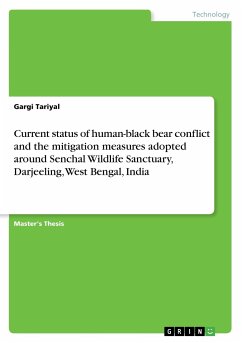
Current status of human-black bear conflict and the mitigation measures adopted around Senchal Wildlife Sanctuary, Darjeeling, West Bengal, India

PAYBACK Punkte
0 °P sammeln!
Master's Thesis from the year 2013 in the subject Environmental Sciences, , language: English, abstract: Asiatic black bear (Ursus thibetanus) is one of the largest carnivores of Senchal Wildlife Sanctuary (WLS). Black bear-human conflict is a major concern throughout the eastern Himalayas and particularly in the Darjeeling district of West Bengal state. A study was undertaken to assess the Black bear-Human conflicts using Questionnaire surveys within the fringe villages of Senchal Wildlife Sanctuary (WLS), West Bengal during the period June-July 2013 by applying snowball-sampling technique. T...
Master's Thesis from the year 2013 in the subject Environmental Sciences, , language: English, abstract: Asiatic black bear (Ursus thibetanus) is one of the largest carnivores of Senchal Wildlife Sanctuary (WLS). Black bear-human conflict is a major concern throughout the eastern Himalayas and particularly in the Darjeeling district of West Bengal state. A study was undertaken to assess the Black bear-Human conflicts using Questionnaire surveys within the fringe villages of Senchal Wildlife Sanctuary (WLS), West Bengal during the period June-July 2013 by applying snowball-sampling technique. The black bear-human conflicts recorded were in three forms: crop raiding, livestock predation, human attacks and sometimes even death of humans. Crop damage was observed to be the most common type of conflict as reported by more than 80% of the respondents. The extent of crop damage was intense in the month of June-September, mainly concentrated along forest boundary areas which can be related to the cropping pattern and pre-hibernation period of black bears. Crop damage and livestock damage was estimated for the areas surveyed. The traditional methods adopted by the villagers to scare or chase off bear included, shouting, drumming empty tin, Bamboo netted fencing , keeping guard dogs and handmade fire mashals (Pultho). However these methods are hardly effective because their applicability lies when the villagers know about the presence of bears in their fields, which is very rare as most of the bear attacks occur during late night hours, when the villagers are in sound sleep. Provision for immediate compensation for crop damage and livestock insurance schemes was suggested by the villagers to mitigate HBC. The willingness of the villagers to adapt to measures to mitigate HBC was found to be directly related to the cooperation provided by the forest officials and NGO's.













